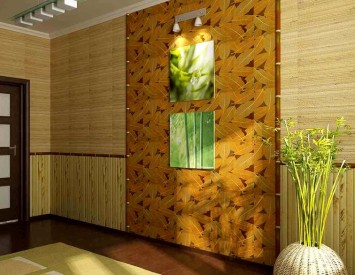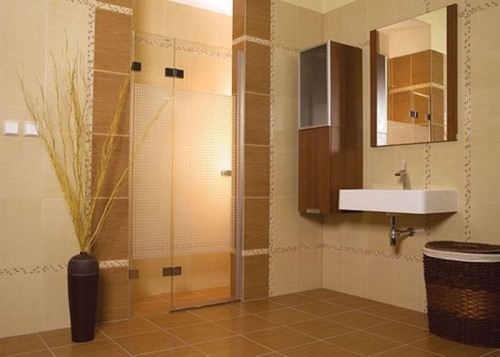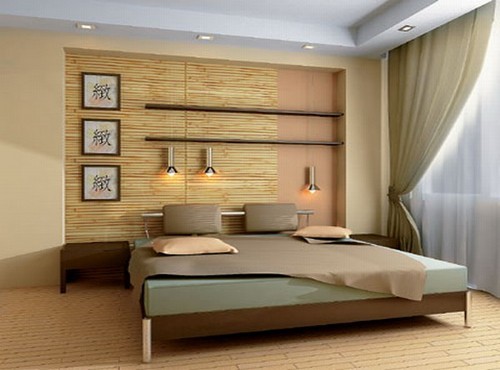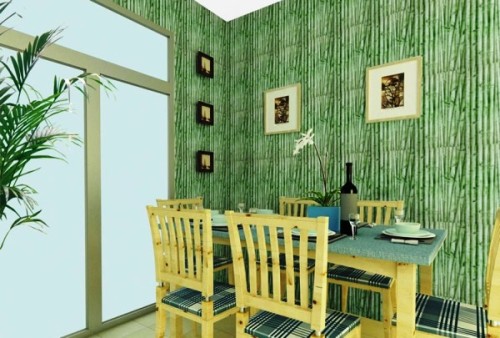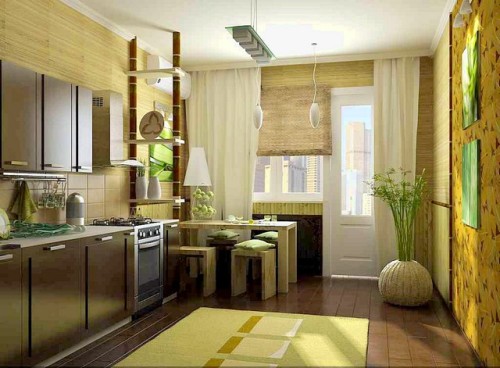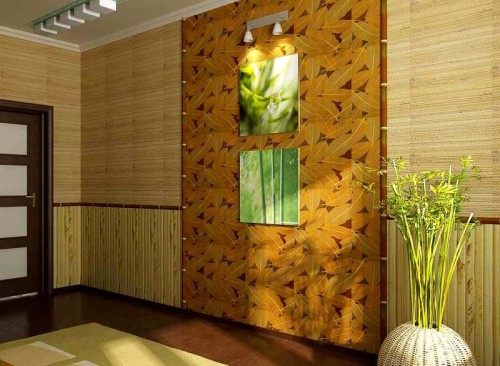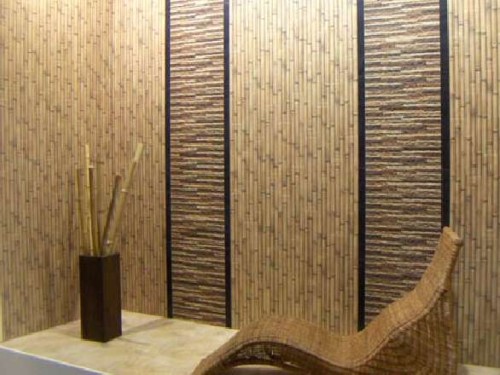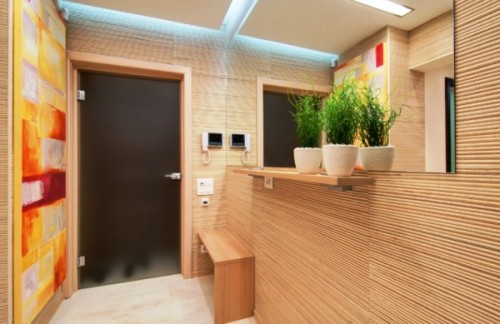Wallpaper is the most common decoration option. The relatively low cost, the ease of work that can be performed independently, the possibility of concealing wall defects - became a guarantee that the decoration of the wallpaper is present in almost 100% of residential premises. The growing fashion for environmental types of finishing materials and oriental motifs in the design of the interiors provided good popularity with bamboo wallpaper. This type of wallpaper has an attractive appearance and excellent performance.
About what bamboo wallpaper is and about the features of their use in the decoration - further.
Content
- What is bamboo wallpaper
- Advantages and disadvantages of bamboo wallpaper
- Bamboo wallpaper gluing in the interior of the room
- Bamboo wallpaper in the interior of the hallway
- Kitchen interior with bamboo wallpaper
- Bamboo wallpaper in the interior: photo
- Bamboo wallpaper in the interior of the bedroom: video
What is bamboo wallpaper
Bamboo wallpaper, as it is not difficult to guess, is made from a famous tropical plant. The rapid growth of bamboo and its widespread distribution in the Asian region made it one of the most affordable natural building materials. The manufacture of wallpaper from the shoots of bamboo consists of several production stages. Initially, the escape of the plants is dissolved into a large number of thin stripes, the width of which is not more than 20 mm (wallpaper with a width of stripes of about 4 mm are found). Then the resulting strips are glued on the base. As the latter, rice paper or one of the varieties of fabric is used.
There are two main types of bamboo wallpaper:
- Made from the outer part of the barrel of the plant.
- Produced from the inside of the barrel of the plant.
The first type of this material has a more natural ornament, as well as a natural heterogeneous surface, which is resistant to ultraviolet radiation. Wallpaper from the outer part of the barrel differ in a rich variety of colors from light olive to chocolate. With uneven firing of the surfaces of the lamellas, they acquire turtle and wenge shades.
Lamels from the inner surface of the trunk have a more smooth surface, which does not tolerate the effects of sunlight too well. That is why they are often opened with colorless varnish. Such wallpapers have only light natural tones. To give them a different color, they are painted or tinted.
Thanks to the special production technology, the structure of the wallpaper becomes dense and quite strong. Environmentally friendly material allows the walls to “breathe”. Moreover, due to its dense structure, such wallpapers can hide quite significant defects in the surface of the wall, which allows reducing the costs of its preparation.
When dried up, bamboo stripes acquire a different shade, which allows the masters, combining them, to make fascinating patterns.
Advantages and disadvantages of bamboo wallpaper
In addition to environmental purity and their dense structure, bamboo canvases have another irreplaceable quality. Bamboo has excellent moisture -resistant properties, which will successfully use them in places of high humidity, such as a bathroom or kitchen.
They perfectly tolerate temperature changes, which makes it possible to use bamboo wallpaper in the interior of unheated rooms, such as attic, balconies, etc.
With all their advantages, bamboo wallpapers have no residues, the main of which remains.
Also, gluing such wallpaper requires the use of special glue, since their weight is greater than the usual ones. It is worth noting that when working with bamboo wallpaper, experience is needed, because gluing such paintings is a rather difficult task.
Despite the shortcomings, the popularity of this finishing material is constantly growing.
Bamboo wallpaper gluing in the interior of the room
The first stage of gluing bamboo wallpaper is the selection of glue. As mentioned above, the water -soluble glue that is used to work with paper or vinyl canvases is not suitable in this case. For this type of finishing material, glue based on vinyl or polychloroprene basis is necessary. Only they can reliably fix the canvas on the surface of the wall. Some professionals advise using liquid nails as a wallpaper glue, which are suitable even for working with a slight variety of ceramics. However, when using it, you will have to select its color to the tone of the wallpaper.
The approximate consumption of glue for bamboo wallpaper during bilateral surfaces is 400 g/m2. Having calculated the area of \u200b\u200bthe walls on which work will be carried out, you can determine the overall consumption of glue for its purchase. You just need to keep in mind that it is better to buy 5-10% more.
When gluing bamboo wallpaper, it is necessary to take into account the fact that they do not bend. That is why manufacturers offer rolls of different widths. In order to reduce the consumption of the material, it is necessary to choose the right canvases. If this cannot be done, then they can be cut off. To do this, without unwinding, the canvas is cut with a hacksaw on metal or an electrician.
After that, the wallpaper must be prepared for work. To do this, cut the necessary stripes according to the size of the walls and lay them out on a flat surface for a day to level humidity in the room and on the surface of the wallpaper.
From the tools you will need:
- a wide brush for applying glue,
- a spatula for leaving wallpaper on the surface and removal of air,
- a rag to remove excess air.
The glue is applied both on the wrong surface of the wallpaper and on the wall, after which it is left for 5-10 minutes so that the composition acquires a certain density.
The wallpaper strip is applied to the wall and is pressed using a spatula. It is necessary to arrange it until a complete fit. Bamboo wallpaper is glued to the joint, removing the remaining glue with a rag. Special decorative moldings are installed in the corners of the room, which are selected under the tone of wallpaper.
In some cases, already glued wallpaper is treated with varnish. This not only gives them an interesting shade, but also noticeably extends the service life.
Bamboo wallpaper does not require special care. They are perfectly washed, so they can easily be used both in the kitchen and in the children's room. Thanks to this property, the lower part of the wall in the hallways and corridors is often finished with bamboo wallpaper.
Bamboo wallpaper in the interior of the hallway
Excellent operational qualities allow the use of bamboo wallpaper in the interior of rooms with high cross -country ability, such as the hallway. The wallowed lower part of the walls using this material will be reliably protected from random stains of dirt and dust. This is especially important if the house has pets. Even the most powerful pollution from their surface can be removed without a trace with an ordinary, damp cloth.
Due to its versatility, and natural materials are perfectly combined with almost all interior details, it will not be difficult to choose bamboo wallpaper for any design solution. It will look great in the hallway in a classic style or with a minimalist design.
Vinyl wallpaper can be an ideal combination for bamboo wallpaper in design. The latter, as a rule, are glued to the upper half, separating from bamboo paintings with special molding. Vinyl wallpapers select light pastel colors, with a large clear pattern. Then, in combination with a natural structure and color background of bamboo wallpaper, they will look very interesting.
Often used to combine various shades of bamboo wallpaper. In this case, one type is used for the background, and various inserts are glued from others.
An excellent solution to use bamboo wallpaper in the interior will be if it is planned to create a small corner of nature among glass and concrete. They are perfectly combined with rotan furniture or the same bamboo, green plants. If upholstered furniture is installed in the hallway, then the most optimal type of upholstery will be leather or flax. They are very beautifully combined with bamboo wall decoration. In general, it is worth noting that bamboo wallpapers are in perfect harmony with all natural decoration materials such as natural stone, wood, brick, ceramics, etc.
Color rules for decorating the hallway with bamboo wallpaper - no. It all depends on the preferences of the owner of the room.
Kitchen interior with bamboo wallpaper
Due to their natural texture, bamboo wallpaper can bring home warmth and special charm to the kitchen interior. They make a change in humidity and temperature changes well. A great combination with ceramic tiles makes this type of canvas a great option for finishing the kitchen. With this material, the kitchen can be given by a Japanese, Scandinavian or even Greek style.
A good combination with this type of decoration will be bamboo blinds that will create comfort in the kitchen in the morning and evening.
Wallpaper collected from large lamellas can easily serve as a kitchen apron at the working surface for a long time without loss of quality. To combine this excellent material with ceramic tiles, it is better to choose the latter with a large natural pattern.
For the perfect combination of bamboo wallpaper with other decor elements, it is necessary to choose a suitable color palette. Light and beige tones go well with them. Natural colors, such as pistachio, olive, light yellow, are perfect.
A good option is a combination of bamboo wallpaper with wallpaper "for painting". On sale there are options with a 3-D print in the form of plant topics. Having painted them in suitable colors, you can achieve an excellent result.
When using bamboo wallpaper in the interior, the most important thing is not to overdo it. Usually they do not finish the whole walls, so as not to feel discomfort and isolation of space. With their help, you can make accents to certain sections of the room.
